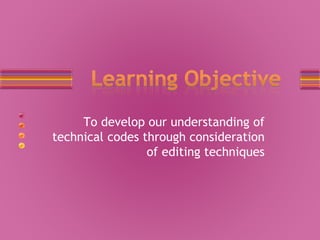
Lesson 3 - editing
- 1. To develop our understanding of technical codes through consideration of editing techniques
- 2. we can analyse: • how long each shot lasts e.g. longer shots = more relaxed mood • the style of edit • the type of transition Technical codes - Editing
- 3. Editing Briefly defined: • The ways one scene changes to the next
- 4. Why is editing important? • The term editing refers to the changing shots within a piece of film. The pace (speed) with which this happens has important role in creating atmosphere. For instance, if there is a car chase on screen, the editing will be rapid, making us excited. A countryside picnic scene, on the other hand, will probably feature slow editing; we relax and take in the details on the screen.
- 5. Continuity Continuity editing • Cutting shots to tell a story with narrative continuity, helping the viewer make sense of the action by implying spatial relationships and ensuring smooth flow from shot to shot. • Realism - edit is invisible so action appears real rather than constructed. • There are 5 key continuity techniques:
- 6. Continuity editing • master shot/establishing shot - This is our establishing or long shot (establishes the space in which action is to happen) • 180 degree rule
- 7. 180 Degree Rule • It is a filming guideline that the participants in a scene should have same left-right relationship to each other. • Breaking the rule can confuse the audience.
- 8. Things are easier to explain with pictures In this scene: • The man is always facing right • The woman is always facing left • Mo matter which position or angle the camera is shooting from, the characters will always be facing the same direction throughout.
- 9. What happens if you cross the line • If you move the camera across the line, characters face the same way as each other • This equals confusion
- 10. How do I cross the line? • Show the movement – This way the viewer wont become disorientated as they will have see the camera move. • Once the line has been cross, all shots must be from that side of the line, unless you cross back over (again showing the movement)
- 12. Continuity editing • master shot/establishing shot • 180 degree rule • shot/reverse shot
- 13. Shot/Reverse shot • Used in filming dialogue / characters looking at each other or objects. • This shot frames the speaker as he says his dialogue, often there will be a part of the listener in the shot, slightly out of focus for example, the shoulder slightly out of focus. • It can be point of view or over the shoulder shot. • This comes in line with the 180 degree rule.
- 16. Continuity editing • master shot/establishing shot • 180 degree rule • shot/reverse shot • eyeline match
- 17. When the character looks off- screen or at something we can’t see, the next shot shows us what they are looking at. This is usually followed up with a close up to show us the reaction of the character – if a
- 18. Why Eyeline match is important
- 19. Continuity editing • master shot/establishing shot • 180 degree rule • shot/reverse shot • eyeline match • match on action
- 20. Match on Action • It is an editing technique for continuity editing in which one shot cuts to another shot portraying the action of the subject in the first shot. • This creates an impression of continuity – visual bridge. The view matches the action. • It portrays a continuous sense of the same action rather than 2 separate scenarios (although you may have shot it at different days). • Watch this scene from the Matrix
- 21. Remember: • Wearing the same clothes • Appears identical to the previous filming time • Lighting (time of day/weather) • Clocks in the view must be same time. • Also if person entering on the left they have to leave on the right.
- 22. Continuity editing • master shot/establishing shot • 180 degree rule • shot/reverse shot • eyeline match • match on action
- 23. Non-Continuity • Montage – giving information in compressed form – can come under… • Non-continuity editing – Continuity is broken and construction is more apparent. Meaning often created through juxtaposition and metaphor shot inserts.
- 24. 4 types of Transitions The process of cutting from one shot to another usually involves a simple straight cut or simply ‘cut’. However there are other means of transition available to a film editor • Fade to black • Dissolve/cross fade • Wipe Watch the clip
